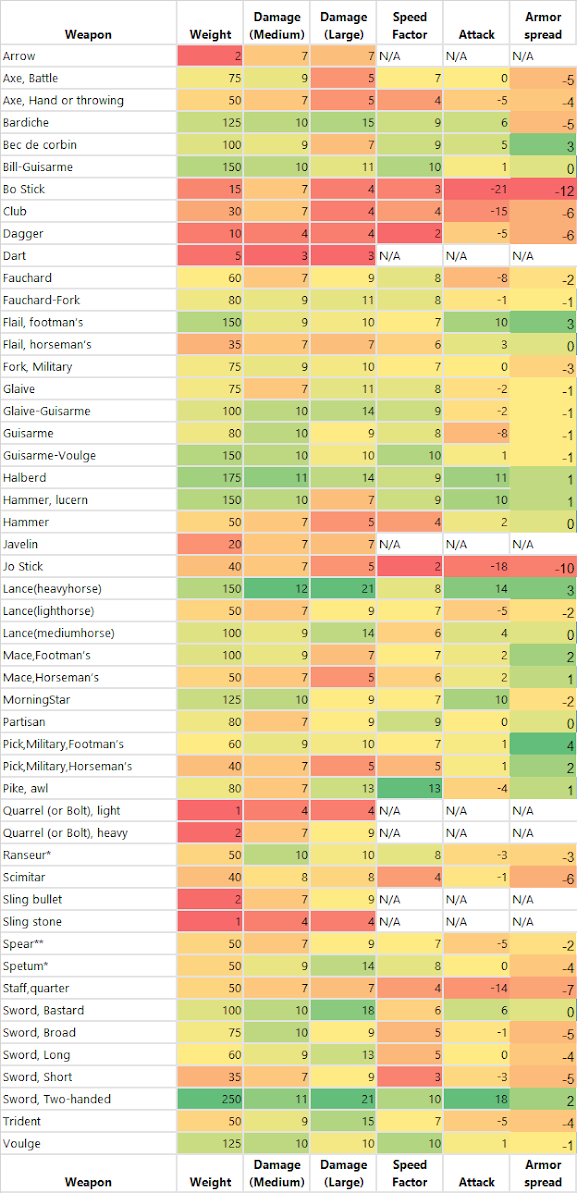"Forget weapon speed factors. I must have been under the influence of a hex when I included them in the bloody rules." - attributed to Gary Gygax.
If you've been reading this blog for a while, you might know I'm a bit obsessed with this stuff.
So, I was taking YES another look at AD&D weapons... and, again, I'm torn.
On one hand, I love the idea of certain weapons being awesome when dealing with heavy armor, or large opponents, or tight spaces... OTOH I think the tables as written are almost unsalvageable.
Take the two handed sword, for example.
* It makes attacking someone in leather armor easier to hit than someone who is unarmored.
* It ignores your shield if you are unarmored, but NOT if you are in leather armor.
* It weights 250 coins. The awl pike (length: 18’+) weights 80 coins.
There is nothing here I want to use. But it also has a few interesting aspects I like:
* It is a decent weapon against MOST types of armor and shields.
* It is a great weapon against large opponents.
AD&D doesn't tell you this, but it shows this is true with many tables and more than a dozen digits. Here is a radical simplification that would still give me everything I want from 2H-sword:
- The 2H-sword has +2 to hit against any armor, and double damage dice (2d10) against large opponents.
Now, instead of analyzing several tables, the player can choose this weapon for clear reasons.
We could extrapolate this further; maybe ALL swords deal double damage against large foes, and ALL two-handed weapons get +2 to hit (thus balancing the loss of a shield).
In order to create these extrapolations/generalizations, I compiled this table (right click to open in a new tab):
- Weights.
- Damage (minimum plus maximum, so "1-4" becomes 5).
- Speed factor (the lower/red, the faster).
- Attack (the sum of all attack bonuses, from AC 9 to AC 2), meaning the weapon hits more often.
- Armor spread (which is the AC 2 bonus minus the AC 9 bonus), meaning the weapon is particularly bad against heavy armor if the number is low/red. Ignore this last column for now.
The colors help us visualize some patterns.
There is a clear tendency of lighter weapons being faster, but weaker against armor and dealing lower damage.
When there is a visible shift in color, we can notice outliers. For example:
- The awl pike is much slower than other weapons of a similar weight, while the lance (heavy warhorse) is significantly faster.
- The bastard sword is very good against large opponents, even in its weight class.
- The short sword is fast for its weight class; in fact, all swords are kinda fast for their weights.
- Some weapons (2H sword, heavy lance, flail, morningstar) hit more often, while others (sticks, fauchard, guisarme) have a harder time hitting ("attack" column).
- The "bec de corbin" and "axe, battle" are both bad against large opponents.
Now, the last column deserves further explanation.
A positive/green number means the weapon gets to partially ignore armor, while a negative/red number means the weapon is particularly weak against heavier armor.
This column has a bit less correlation to "weight class". But there are some rules that seem easy to generalize:
- Picks, flails, maces and heavy lances/2h-swords are good against heavy armor.
- Axes, daggers and swords are bad against heavy armor.
- Sticks/staves are terrible against heavy armor.
So... I still don't know what to make of this. I guess my desire is to make a series of small affirmations that could be easier understood and applied ("picks, flails and 2h-swords get +2 against armor", etc.).
An earlier effort resulted in this, which was good but still not quite what I'm looking for.
My next guess is that we could play with the idea of "combat maneuvers" or "special attacks", with some weapons being better doing a "ignore armor" maneuvers, others with a "fast attack", etc.
Another idea is making clear certain weapons are better against giants, other against undead, oozes, etc.
But I'll leave that to another day. This exercise was interesting but a bit frustrating; it almost seems like any effort to streamline this stuff is in vain, and we'd be better off consulting tables.


No comments:
Post a Comment